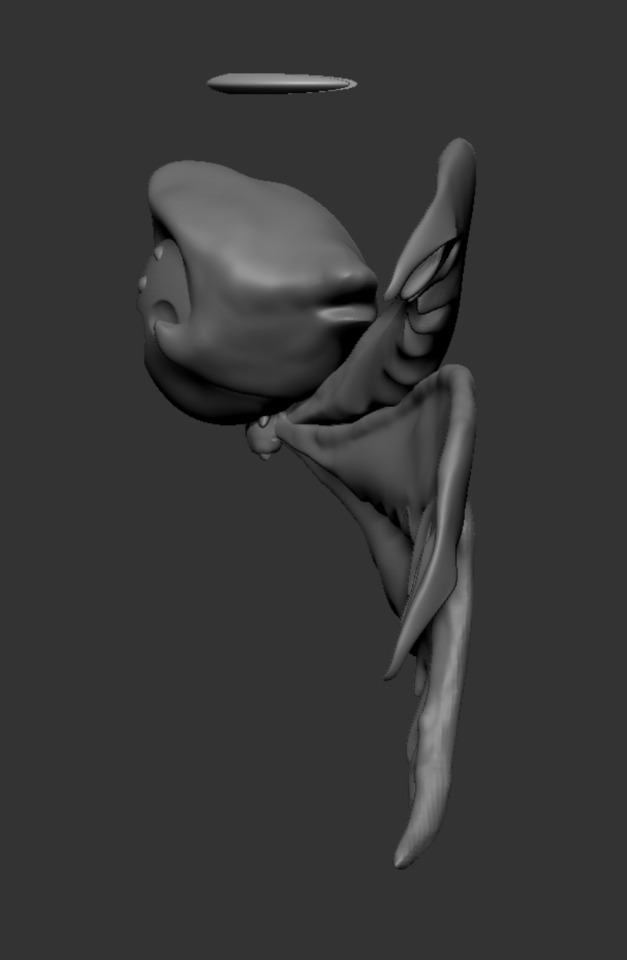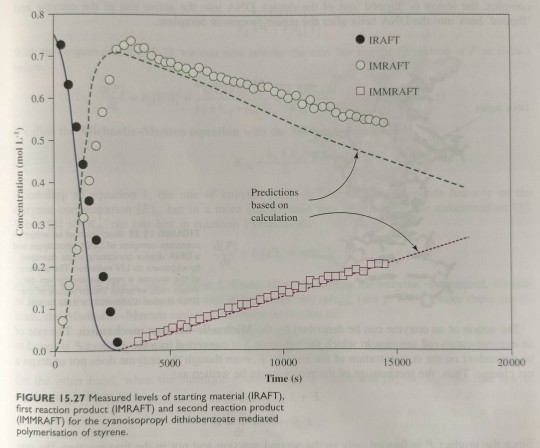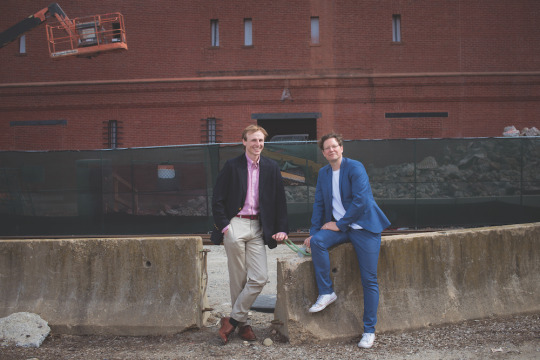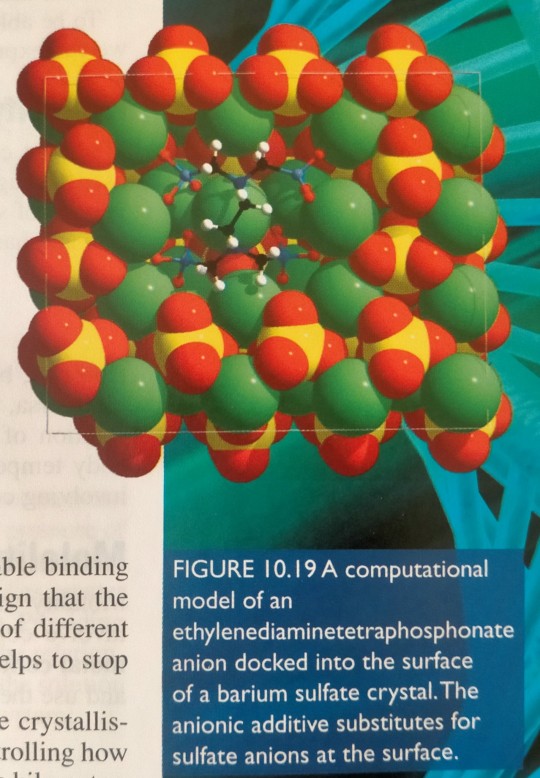#computer modeling
Explore tagged Tumblr posts
Text
pre-fallen tiny little itty bitty body Lucifer? YES PLEASE
this was SO FUN to make


modeled by me for an assignment, design originally by @diabloku in their "ALASTOR'S VICIOUS MOCKERY" video


youtube
(some more angles and a bonus cursed alternate version under the cut)
_______
some more angles to answer a question some people might have, like "HOW DID YOU EVEN GET THOSE WINGS TO FIT ON HIS BODY" (a few people asked me that lol. or at least one person did. i think a second person--ANYWAY)
answer: curve the wings out A LOT away from the body and give them tiny bases


BONUS: I HAD TOO MUCH FUN AND FORGOT THE ASSIGNMENT WAS ACTUALLY TO CREATE A BUST (HEAD AND SHOULDERS), NOT A WHOLE BODY, AND I DIDN'T KNOW HOW PEDANTIC MY PROFESSOR WOULD BE, SO I MADE THIS VERSION TOO

i wish i remembered to include his collarbone and some neck muscles. it would have been even more cursed
(more bonus info: i'm new-ish to the program we're using [ZBrush], so i didn't realize there's a torus -- a ring -- object i could have used for the halo. so i squashed a sphere and tried to cut a circle out from the center, but the program didn't cooperate. so i instead gave him a semi-halo thing lol)
#hazbin hotel#hazbin lucifer#lucifer morningstar#hazbin hotel lucifer#rexan's art#zbrush#3d modeling#3d art#computer modeling#it was so silly that i collected a bunch of bird wing references and then hardly used them or my knowledge from past projects lol#Youtube
473 notes
·
View notes
Text
Centriole Building
The centriole – an organelle vital for the faithful separation into each daughter cell when a cell divides – is composed of an assembly of proteins. Using expansion microscopy, this study correlates the spatial location of 24 of those proteins with structural features of the human centriole, and then models the molecular architecture of the centriole as it assembles (shown here)
Read the published research article here
Video from work by Marine H. Laporte and colleagues
University of Geneva, Department of Molecular and Cellular Biology, Faculty of Sciences, Geneva, Switzerland
Video originally published with a Creative Commons Attribution 4.0 International (CC BY-NC 4.0)
Published in Cell, April 2024
You can also follow BPoD on Instagram, Twitter and Facebook
#science#biomedicine#biology#cell division#centrioles#centrosome#computer modeling#expansion microscopy
15 notes
·
View notes
Text
Researchers make game-changing breakthrough with 'breathing' energy tech: 'Combines strong performance with simplicity'
Researchers make game-changing breakthrough with 'breathing' energy tech: 'Combines strong performance with simplicity' https://share.google/a2qiwywEtDsLdrGbW
A new 'breathing' battery tech promises to store green energy & to clean the air as well!!
Early research shows that the lithium mix inside, reacts with CO² to make electricity & at the same time, this mix traps CO² gas & stores the energy released!
A new battery design & an affordable compound lets it charge more efficiently, run longer & hold more energy.
It also loses far less energy as it charges & during its use.
Computer modeling let the research team to see the chemical reactions work - from inside the battery!!
These would make for powerful batteries in solar panels & EVs.
Even better, they'd help reduce emissions & cut energy costs - all while they also help to clean the air...
Strangely enough, this tech would be perfect for use on the planet Mars! There, carbon dioxide is, by far, the dominant gas in the atmosphere.
But, more work is needed before a finished battery is finally available...
Not the End!
#breathing#battery#green energy#CO²#Surrey U#lithium#affordable#compound#renewable power source#computer modeling#chemical reactions#solar panels#EVs#reduce#emissions#&#energy costs#perfect 4#Mars
0 notes
Text
Comprehensive Seismic Engineering Design Services Offered by Little P.Eng. and its Importance in Piping Stress Analysis
In the world of engineering and construction, seismic engineering is a specialized field crucial for ensuring the safety and resilience of structures in earthquake-prone regions. Little P.Eng. is a renowned seismic engineering firm that provides a wide range of services to address the unique challenges posed by seismic activity. In this comprehensive article, we will explore the multitude of services offered by Little P.Eng., highlighting their expertise, innovation, and dedication to creating structures that can withstand the forces of nature.
Seismic Risk Assessment
One of the foundational services offered by Little P.Eng. is seismic risk assessment. Before embarking on any seismic engineering project, it's essential to understand the level of risk posed by potential earthquakes in a specific area. Little P.Eng. utilizes advanced methodologies and data analysis to assess seismic hazards accurately. This assessment helps clients make informed decisions about construction and retrofitting, ensuring the safety of occupants and the protection of valuable assets.
Structural Analysis and Design
Seismic engineering begins with the structural analysis and design of buildings and infrastructure. Little P.Eng.'s team of experienced engineers specializes in developing seismic-resistant structural systems. They work closely with architects, builders, and developers to create designs that can withstand seismic forces, ensuring structural integrity and occupant safety during earthquakes.
Retrofitting Existing Structures
In regions with older buildings, retrofitting is often necessary to bring them up to current seismic safety standards. Little P.Eng. offers retrofitting services that involve the modification and strengthening of existing structures. Their engineers assess the specific needs of each building, considering factors such as its age, construction materials, and seismic vulnerabilities. They then implement retrofitting strategies that enhance the building's earthquake resistance, preserving its historical value while ensuring safety.
Foundation Design and Soil Analysis
The foundation is the bedrock of any structure's stability during an earthquake. Little P.Eng. conducts in-depth soil analysis to understand the geotechnical characteristics of the site. Based on this analysis, they design and recommend appropriate foundation systems tailored to the specific needs of the project. Their expertise in foundation design ensures that structures can effectively dissipate seismic forces into the ground, preventing catastrophic failure.
Compliance with Seismic Codes
Adherence to seismic codes and standards is paramount in seismic engineering. Little P.Eng. has an in-depth understanding of local, national, and international building codes related to earthquake-resistant construction. They ensure that all their designs and retrofitting projects comply with these regulations, providing clients with peace of mind that their structures meet the highest safety standards.
Advanced Computer Modeling and Simulation
Little P.Eng. leverages cutting-edge computer modeling and simulation tools to analyze and predict how structures will respond to seismic forces. These simulations allow for precise refinement of designs and provide valuable insights into structural performance during earthquakes. By simulating a wide range of seismic scenarios, engineers can optimize designs for maximum safety and efficiency.
Continuous Monitoring and Evaluation
The commitment of Little P.Eng. extends beyond the design and construction phase. They recommend and implement structural health monitoring systems that allow for real-time assessment of a building's integrity. Continuous monitoring enables early detection of potential issues, ensuring prompt maintenance or repairs to preserve structural stability.
Research and Innovation
Innovation is at the heart of Little P.Eng.'s approach to seismic engineering. Their team actively engages in research and development to push the boundaries of seismic-resistant technologies and construction practices. They explore innovative materials, construction techniques, and design methodologies to advance the field and provide clients with the latest and most effective solutions.
Emergency Response Planning
In addition to structural engineering services, Little P.Eng. assists communities, businesses, and organizations in developing emergency response plans for seismic events. They collaborate with stakeholders to create comprehensive strategies for minimizing risks, protecting lives, and reducing damage during earthquakes.
Public Education and Outreach
Little P.Eng. recognizes the importance of public awareness and education regarding seismic risks and safety. They engage in outreach programs to educate communities on earthquake preparedness, emergency response, and the importance of seismic-resistant construction.
Conclusion

Seismic engineering design plays a crucial role in piping stress analysis within industrial facilities, especially in regions prone to earthquakes. Piping stress analysis involves evaluating the forces and stresses that piping systems experience during various operational conditions, including seismic events.
Here's how seismic engineering design is important for piping stress analysis:
Safety and Structural Integrity: Seismic engineering design ensures that the entire facility, including piping systems, is built to withstand the forces generated by earthquakes. The structural integrity of piping systems is paramount for preventing leaks, ruptures, or catastrophic failures during seismic events. Piping stress analysis assesses the impact of seismic forces on the pipes, supports, and attachments to verify that they can withstand the dynamic loads and deformations caused by earthquakes.
Compliance with Building Codes: Piping systems within industrial facilities must adhere to building codes and standards related to earthquake-resistant design. Seismic engineering design ensures that piping systems are compliant with these codes. Non-compliance can lead to costly retrofitting efforts or, in the worst-case scenario, dangerous failures during an earthquake.
Identifying Vulnerabilities: Seismic engineering design involves conducting a seismic risk assessment for the facility. This assessment helps identify vulnerabilities in the piping systems, such as weak points in support structures or connections that may be prone to failure during seismic events. Piping stress analysis considers these vulnerabilities and recommends improvements to enhance seismic resilience.
Optimal Pipe Routing and Support: Piping stress analysis incorporates considerations for seismic forces when determining the routing of pipes and the design of pipe supports. Proper pipe routing and support are essential to prevent excessive stresses, vibrations, and displacements during an earthquake. Seismic engineering design helps optimize these factors to minimize potential damage to the piping systems.
Dynamic Load Analysis: Seismic events introduce dynamic loads on piping systems, which are significantly different from static loads. Piping stress analysis uses dynamic load analysis techniques to simulate the effects of seismic forces on pipes, fittings, and supports. This analysis ensures that the piping systems can handle the dynamic loads without exceeding their stress limits.
Retrofitting and Modifications: In existing facilities, seismic engineering design may involve retrofitting or modifying piping systems to meet current seismic standards. Piping stress analysis helps identify areas that require reinforcement, redesign, or additional support. Retrofitting ensures that older facilities can withstand seismic events and meet modern safety requirements.
Mitigation Strategies: Seismic engineering design doesn't only focus on evaluating existing conditions but also includes the development of mitigation strategies. These strategies may involve the use of seismic expansion joints, dampers, or flexible connectors to absorb seismic energy and reduce stress on the piping systems.
Emergency Response Planning: In the event of a seismic event, having a well-designed piping system is crucial for quick recovery and minimizing damage. Seismic engineering design contributes to emergency response planning by ensuring that piping systems are less likely to rupture or leak during an earthquake, reducing potential hazards and environmental damage.
In summary, seismic engineering design is vital for piping stress analysis because it ensures the safety, compliance, and resilience of piping systems in the face of seismic events. It helps identify vulnerabilities, optimize designs, and implement mitigation measures, ultimately safeguarding industrial facilities and the surrounding environment during earthquakes.
The listing below indicates a few of Meena Development’s most commonly served industries.
Steel and Metals Industry
Energy and Power Generation Industry
Water and Wastewater Industry
Oil & Gas Industry
Chemicals and Plastics Industry
Pulp & Paper Industry
Facility Services
Residential Buildings Sector
Hospitality and Hotel Sector
Commercial Buildings Sectors
Sports and Stadia Buildings Sector
Education Buildings Sector
Government Buildings Sector
Hospitals Engineering Services
Biotech / Pharmaceutical – Engineering Services
Food & Beverage – Engineering Services
Tags:
Meena Rezkallah
Little P.Eng.
piping stress analysis
Piping stress analysis
Structural analysis
Seismic engineering
Seismic risk assessment
Retrofitting
Foundation design
Compliance with seismic codes
Computer modeling
Advanced simulation
Optimal pipe routing
Support systems
Pipe design
Seismic forces
Seismic expansion joints
Flexible connectors
Engineering Services
Pipe Stress Analysis Services
Seismic Bracing Experts
Located in Calgary, Alberta; Vancouver, BC; Toronto, Ontario; Edmonton, Alberta; Houston Texas; Torrance, California; El Segundo, CA; Manhattan Beach, CA; Concord, CA; We offer our engineering consultancy services across Canada and United States. Meena Rezkallah.
#•#Meena Rezkallah#Little P.Eng.#piping stress analysis#Piping stress analysis#Structural analysis#Seismic engineering#Seismic risk assessment#Retrofitting#Foundation design#Compliance with seismic codes#Computer modeling#Advanced simulation#Optimal pipe routing#Support systems#Pipe design#Seismic forces#Seismic expansion joints#Flexible connectors
0 notes
Text
Even for complex polymeric reactions, researchers at the Australian National University have developed chemically accurate techniques for predicting rate constants and have used them to successfully predict the outcomes of multi-component polymerisation processes (see figure 15.27).

"Chemistry" 2e - Blackman, A., Bottle, S., Schmid, S., Mocerino, M., Wille, U.
#book quotes#chemistry#nonfiction#textbook#computer modeling#australian national university#prediction#iraft#imraft#immraft#polymerization#chemical reactions
1 note
·
View note
Text


"Now, the vow will be honoured, and my Lord brother's soul will return."
Radahn stans keep winning, but I personally am in Miyazaki's walls rn
#my art#shadow of the erdtree spoilers#sote spoilers#shadow of the erdtree#elden ring#godwyn prince of death#godwyn the golden#miquella the kind#miquella the unalloyed#promised consort radahn#fromsoft#i do not think critiques of radahn are as shallow as “pay $40 to fight a boss we already fought”#the dlc is good right up until the final boss#most of the new bosses are good#i loved midra and metyr and messmer and the dancing lion#radahn as consort just comes completely out of left field and just seems like a huge disconnect between the dlc and base game#radahn's story was done with the festival#and it's a good end! i like the festival and the base game radhan fight#but here he shows up again out of nowhere when godwyn is the obvious choice and a godwyn boss fight would be new and interesting#you can even still have your villain miquella story#puppeting his brother's living-but-soulless corpse unable to accept#that just because godwyn is breathing and follows his command like a deprecated computer program#even godhood can't bring his brother's soul back#his body must be slain and he must die a true death#we could have at least gotten a line of dialogue from radahn but nope#ok rant over#this pic is sloppy but idc#no cleanup we die like men#yes i know miquella's model technically has only three arms but i gave him four bc three looks silly
2K notes
·
View notes
Photo

Cutting urban carbon emissions by retrofitting buildings Study shows that cities’ plans often won’t achieve their goals, but decarbonizing the local grid could make the difference. https://news.mit.edu/2023/cutting-urban-carbon-emissions-retrofitting-buildings-0713
#School of Architecture and Planning#Architecture#MIT Energy Initiative#Energy#Energy efficiency#Climate change#Emissions#Greenhouse gases#Sustainability#Policy#Computer modeling#Research#Cities#Nancy W. Stauffer | MIT Energy Initiative#MIT News
0 notes
Text



A bunch of modelling stuff I made for my partner @kittehburger 's oc Widget!! Isn't he goregous
#objectum#computer#technology#tech#techum#objectophilia#mechaphilia#computer oc#my art#3d model#doyoulikemyturnip#blender3d
3K notes
·
View notes
Text


narcellie
#aesthetic#grunge#crystal castles#fashion#gothic#fashion model#model inspo#style#y2k aesthetic#y2k#y2kcore#y2k nostalgia#2000s aesthetic#cyber core#model icons#cybercore#futuristic#computer#techcore#web
540 notes
·
View notes
Text
A profoundly stupid case about video game cheating could transform adblocking into a copyright infringement

I'm coming to DEFCON! On Aug 9, I'm emceeing the EFF POKER TOURNAMENT (noon at the Horseshoe Poker Room), and appearing on the BRICKED AND ABANDONED panel (5PM, LVCC - L1 - HW1–11–01). On Aug 10, I'm giving a keynote called "DISENSHITTIFY OR DIE! How hackers can seize the means of computation and build a new, good internet that is hardened against our asshole bosses' insatiable horniness for enshittification" (noon, LVCC - L1 - HW1–11–01).

Here's a weird consequence of our societal shift from capitalism (where riches come from profits) to feudalism (where riches come from rents): increasingly, your rights to your actual property (the physical stuff you own) are trumped by corporations' metaphorical "intellectual property" claims.
That's a lot to unpack! Let's start with a quick primer on profits and rents. Capitalists invest money in buying equipment, then they pay workers wages to use that equipment to produce goods and services. Profit is the sum a capitalist takes home from this arrangement: money made from paying workers to do productive things.
Now, rents: "rent" is the money a rentier makes by owning a "factor of production": something the capitalist needs in order to make profits. Capitalists risk their capital to get profits, but rents are heavily insulated from risk.
For example: a coffee shop owner buys espresso machines, hires baristas, and rents a storefront. If they do well, the landlord can raise their rent, denying them profits and increasing rents. But! If a great new cafe opens across the street and the coffee shop owner goes broke, the landlord is in great shape, because they now have a vacant storefront they can rent, and they can charge extra for a prime location across the street from the hottest new coffee shop in town.
The "moral philosophers" that today's self-described capitalists claim to worship – Adam Smith, David Ricardo – hated rents. For them, profits were the moral way to get rich, because when capitalists chase profits, they necessarily chase the production of things that people want.
When rentiers chase rents, they do so at the expense of profits. Every dollar a capitalist pays in rent – licenses for IP, rent for a building, etc – is a dollar that can't be extracted in profit, and then reinvested in the production of more goods and services that society desires.
The "free markets" of Adam Smith weren't free from regulation, they were free from rents.
The moral philosophers' hatred of rents was really a hatred of feudalism. The industrial revolution wasn't merely (or even primarily) the triumph of new machines: rather, it was the triumph of profits over rent. For the industrial revolution to succeed, the feudal arrangement had to end. Capitalism is incompatible with hereditary lords receiving guaranteed rents from hereditary serfs who are legally obliged to work for them. Capitalism triumphed over feudalism when the serfs were turned off of the land (becoming the "free labor" who went to work in the textile mills) and the land itself was given over to sheep grazing (providing the wool for those same mills).
But that doesn't mean that the industrial revolution invented profits. Profits were to be found in feudal societies, wherever a wealthy person increased their wealth by investing in machines and hiring workers to use them. The thing that made feudalism feudal was how conflicts between rents and profits cashed out. For so long as the legal system elevated the claims of rentiers over the claims of capitalists, the society was feudal. Once the legal system gave priority to profit over rent, it became capitalist.
Capitalists hate capitalism. The engine of capitalism is insecurity. The successful capitalist is like the fastest gun in the old west: there's always a young gun out there looking to "disrupt" their fortune with a new invention, product, or organizational strategy that "creatively destroys" the successful businesses of the day and replaces them with new ones:
https://locusmag.com/2024/03/cory-doctorow-capitalists-hate-capitalism/
That's a hard way to live, with your every success serving as a blinking KICK ME sign visible to every ambitious person in the world. Precarity makes people miserable and nuts:
https://pluralistic.net/2024/04/19/make-them-afraid/#fear-is-their-mind-killer
So capitalists universally aspire to become rentiers and investors seek out companies that have a plan to extract rent. This is why Warren Buffett is so priapatic for companies with "moats and walls" – legal privileges and market structures that protect the business from competition and disruption:
https://finance.yahoo.com/news/warren-buffett-explains-moat-principle-164442359.html
Feudal rents were mostly derived from land, but even in the feudal era, the king was known to reward loyal lickspittles with rents over ideas. The "patents royal" were the legally protected right to decide who could make or do certain things: for example, you might have a patent royal over the production of silver ribbon, and anyone who wanted to make a silver ribbon would have to pay for your permission. If you chose to grant that permission exclusively to one manufacturer, then no one else could make it, and you could charge a license fee to the manufacturer that accounted for nearly all their profit.
Today, rentiers are also interested in land. Bill Gates is the country's number one landowner, and in many towns, private equity landlords are snappinig up every single family home that hits the market and converting it to a badly maintained slum:
https://pluralistic.net/2024/05/22/koteswar-jay-gajavelli/#if-you-ever-go-to-houston
But the 21st Century's defining source of rent is "IP" – a controversial term that I use here to mean, "Any law or policy that allows a company to exert legal control over its competitors, critics and customers":
https://locusmag.com/2020/09/cory-doctorow-ip/
IP is in irreconcilable conflict with real property rights. Think of HP selling you a printer and wanting to decide which ink you use, or John Deere selling you a tractor and wanting to tell you who can fix it. Or, for that matter, Apple selling you a phone and dictating which software you are allowed to install on it.
Think of Unity, a company that makes tools for video-game makers, demanding a royalty from every game that is eventually sold, calling this "shared success":
https://pluralistic.net/2023/10/03/not-feeling-lucky/#fundamental-laws-of-economics
Every time one of these conflicts ends with IP's triumph over real property rights, that is a notch in favor of calling the world we live in now "technofeudalist" rather than "technocapitalist":
https://pluralistic.net/2023/09/28/cloudalists/#cloud-capital
Once you start to think of "IP" as "laws that let me control how other people use their real property," a lot of the seemingly incoherent fights over IP snap into place. This also goes a long way to explaining how otherwise sensible people can agree on expansions of IP to achieve some short-term goal, irrespective of the spillover harms from such a move. Hard cases make bad law, and hard IP cases make terrible law.
Five years ago, some anti-fascist counterdemonstrators hit on the clever idea of blaring top 40 music during neo-Nazi marches, on the theory that this would prevent Nazis from uploading videos of their marches to Youtube and other platforms, whose filters would block any footage that included copyrighted music:
https://memex.craphound.com/2019/07/23/clever-hack-that-will-end-badly-playing-copyrighted-music-during-nazis-rallies-so-they-cant-be-posted-to-youtube/
Thankfully, this didn't work, but not for lack of trying. And it might still work, if calls for beefing up video copyright filters are heeded. Cops all over the place are already blaring Taylor Swift songs and Disney tunes to prevent their interactions with the public from being uploaded:
https://pluralistic.net/2022/04/07/moral-hazard-of-filternets/#dmas
The same thinking that causes progressives to recklessly argue in favor of upload filters also causes them to demand that web scraping be treated as a copyright crime. They think they're creating a world where AI companies can't rip off their creation to train a model; they're actually creating a world where the Internet Archive can't capture JD Vance's embarrassing old podcast appearances or newspaper editorial boards' advocacy for positions they now recant:
https://pluralistic.net/2023/09/17/how-to-think-about-scraping/
It's not that Nazi marches are good, or that scraping can't be bad – it's just that advocating for the use of IP to address either is a cure that's not just worse than the disease – it's also not a cure.
A problem can be real, and still not be solvable with IP. I have enormous sympathy for gamers who rail against cheaters who use aftermarket hacks to improve their aim, see through buildings, or command other unfair advantages.
If you want to tell a stranger how they must configure their PC or console, IP ("any law that lets you control your competitors, critics or customers") is an obvious answer. But – as with other attempts to solve real problems with IP – this is a cure that is both worse than the disease, and also not a cure after all.
Back in 2002, Blizzard sued some hobbyists over a program called "bnetd." Bnetd was a program that provided a game-server you could connect to with the Blizzard games that you'd bought. It was created as an alternative to Battlenet, Blizzard's notoriously unreliable game-server software that left gamers frustrated and furious due to frequent outages:
https://www.eff.org/cases/blizzard-v-bnetd
To the public, Blizzard made several arguments against bnetd. They claimed that it encouraged piracy, because – unlike the official Battlenet servers – it didn't check whether the copies of Blizzard software that connected to it had a valid license key. Gamers didn't really care about that, but they did respond to another argument: that bnetd lacked the anti-cheat checking of Battlenet.
But that wasn't what Blizzard took to the court: in court, they argued that the hobbyists who made bnetd violated copyright law. Specifically, Section 1201 of the Digital Millennium Copyright Act, which bans "circumvention of access controls to copyrighted works." Basically, Blizzard argued that bnetd's authors violated the law because they used debuggers to examine the software they'd paid for, while it ran on their own computers, to figure out how to make a game server of their own.
Blizzard didn't sue bnetd's authors for pirating Blizzard software (they didn't – they'd paid for their copies). They didn't sue them for abetting other gamers' piracy. They certainly didn't sue them for making a cheat-friendly game-server.
Blizzard sued them for analyzing software they'd paid for, while it was running on their own computers.
Imagine if Walmart – one of the biggest book-retailers in America – had a policy that said that you could only shelve the books you bought at Walmart on shelves that you also bought at Walmart. Now imagine that Walmart successfully argued that measuring the books you bought from them and using those measurements to create your own compatible book-case violated their IP rights!
This is an outrageous triumph of IP rights over real property rights, and yet gamers vocally backed Blizzard in the early noughts, because gamers hate cheaters and because IP law is (correctly) understood as "the law that lets a company tell you how you can use your own real, physical property." Hard cases make bad law, hard IP cases make batshit law.
It's more than 20 years since bnetd, and cheating continues to serve as a Trojan horse to smuggle in batshit new IP laws. In Germany, Sony is suing the cheat-device maker Datel:
https://torrentfreak.com/sonys-ancient-lawsuit-vs-cheat-device-heads-in-right-direction-sonys-defeat-240705/
Sony argues that the Datel device – which rewrites the contents of a player's device's RAM, at the direction of that player – infringes copyright. Sony claims that the values that its programs write to your device's RAM chips are copyrighted works that it has created, and that altering that copyrighted work makes an unauthorized derivative work, which infringes its copyright.
Yes, this is batshit, and thankfully, Sony has been thwarted in court to date, but it is steaming ahead to the EU's highest court. If it succeeds, then it will open up every tool that modifies your computer at your direction to this kind of claim.
How bad can it be? Well, get this: the German publishing giant Axel Springer (owned by a monomaniacal Trumpist and Israel hardliner who has ordered journalists in his US news outlets to go easy on both) is suing Eyeo, makers of Adblock Plus, on the grounds that changing HTML to block an ad creates a "derivative work" of Axel Springer's web-pages:
https://torrentfreak.com/ad-blocking-infringes-copyright-ancient-sony-cheat-lawsuit-may-prove-pivotal-240729/
Axel Springer's filings cite the Sony/Datel case, using it to argue that their IP rights trump your property rights, and that you can only configure your web-browser, running on your computer, which you own, in ways that it approves of.
Axel Springer's war on browsers is a particularly pernicious maneuver, because browsers are the best example we have of internet software that serves as a "user agent." "User agent" is an old-timey engineering synonym for "browser" that reflects the browser's role: to go out onto the web on your behalf and bring back things for you, which it displays in the way you prefer:
https://pluralistic.net/2024/05/07/treacherous-computing/#rewilding-the-internet
Want to block flickering GIFs to forestall photosensitive epileptic servers? Ask your user agent to find and delete them. Want to shift colors into a gamut that accounts for your color-blindness? Ask your user-agent:
https://dankaminsky.com/2010/12/15/dankam/
Want to goose the font size and contrast so you can read the sadistic grey-on-white type that young designers use in the mistaken belief that black-on-white type is "hard on the eyes"? That's what Reader Mode is for:
https://frankgroeneveld.nl/2021/08/24/most-underused-browser-feature/
The foundation of any good digital relationship is a device that works for you, not for the people who own the servers you connect to. Even if they don't plan on screwing you over by directing your user agent to attack you on their behalf right now, the very existence of a facility in your technology that causes it to betray you, by design, is a moral hazard that inevitably results in your victimization:
https://pluralistic.net/2023/08/02/self-incrimination/#wei-bai-bai
"IP" ("a law that lets me control how you use your own property") is a tempting solution to every problem, but ultimately, IP ends up magnifying the power of the already powerful, in contests where your only hope of victory is having a user agent whose only loyalty is to you.
The monotonic, dangerous expansion of IP reflects the growing victory of rents over profits – income from owning things, rather than income from doing things. Everyday people may argue for IP in the belief that it will solve their immediate problems – with AI, or Nazis, or in-game cheats – but ultimately, the expansion of a law that limits how you can use your property (including your capital) to uses that don't threaten neofeudalists will doom you to technoserfdom.

Support me this summer on the Clarion Write-A-Thon and help raise money for the Clarion Science Fiction and Fantasy Writers' Workshop!

If you'd like an essay-formatted version of this post to read or share, here's a link to it on pluralistic.net, my surveillance-free, ad-free, tracker-free blog:
https://pluralistic.net/2024/07/29/faithful-user-agents/#hard-cases-make-bad-copyright-law
#pluralistic#torrentfreak#sony#axel springer#germany#copyright#copyfight#felony contempt of business model#bnetd#computer programs directive#eu#datel#cjeu#ip#adblocking#adblock plus#eyeo#bgh#action replay#feudalism#capitalism#rents#profits
977 notes
·
View notes
Text
Behind the Wave
Computer model of a 'carpet' of beating cilia – the whisker-like structures on many body cell types that sense or waft – reveals the mechanism of their synchronisation. Watch the emergence of a metachronal wave (a Mexican wave is one of these)
Read the published research paper here
Video adapted from work by David J. Hickey, Ramin Golestanian and Andrej Vilfan
Department of Living Matter Physics, Max Planck Institute for Dynamics and Self-Organization, Göttingen, Germany
Video originally published with a Creative Commons Attribution 4.0 International (CC BY 4.0)
Published in Proceedings of the National Academy of Science (PNAS), September 2023
You can also follow BPoD on Instagram, Twitter and Facebook
17 notes
·
View notes
Text
Studying astrophysically relevant plasma physics
New Post has been published on https://thedigitalinsider.com/studying-astrophysically-relevant-plasma-physics/
Studying astrophysically relevant plasma physics


Thomas Varnish loves his hobbies — knitting, baking, pottery — it’s a long list. His latest interest is analog film photography. A picture with his mother and another with his boyfriend are just a few of Varnish’s favorites. “These moments of human connection are the ones I like,” he says.
Varnish’s love of capturing a fleeting moment on film translates to his research when he conducts laser interferometry on plasmas using off-the-shelf cameras. At the Department of Nuclear Science and Engineering, the third-year doctoral student studies various facets of astrophysically relevant fundamental plasma physics under the supervision of Professor Jack Hare.
It’s an area of research that Varnish arrived at organically.
A childhood fueled by science
Growing up in Warwickshire, England, Varnish fell in love with lab experiments as a middle-schooler after joining the science club. He remembers graduating from the classic egg-drop experiment to tracking the trajectory of a catapult, and eventually building his own model electromagnetic launch system. It was a set of electromagnets and sensors spaced along a straight track that could accelerate magnets and shoot them out the end. Varnish demonstrated the system by using it to pop balloons. Later, in high school, being a part of the robotics club team got him building a team of robots to compete in RoboCup, an international robot soccer competition. Varnish also joined the astronomy club, which helped seed an interest in the adjacent field of astrophysics.
Varnish moved on to Imperial College London to study physics as an undergraduate but he was still shopping around for definitive research interests. Always a hands-on science student, Varnish decided to give astronomy instrumentation a whirl during a summer school session in Canada.
However, even this discipline didn’t quite seem to stick until he came upon a lab at Imperial conducting research in experimental astrophysics. Called MAGPIE (The Mega Ampere Generator for Plasma Implosion Experiments), the facility merged two of Varnish’s greatest loves: hands-on experiments and astrophysics. Varnish eventually completed an undergraduate research opportunity (UROP) project at MAGPIE under the guidance of Hare, his current advisor, who was then a postdoc at the MAGPIE lab at Imperial College.
Part of Varnish’s research for his master’s degree at Imperial involved stitching together observations from the retired Herschel Space Telescope to create the deepest far-infrared image ever made by the instrument. The research also used statistical techniques to understand the patterns of brightness distribution in the images and to trace them to specific combinations of galaxy occurrences. By studying patterns in the brightness of a patch of dark sky, Varnish could discern the population of galaxies in the region.
Move to MIT
Varnish followed Hare (and a dream of studying astrophysics) to MIT, where he primarily focuses on plasma in the context of astrophysical environments. He studies experimental pulsed-power-driven magnetic reconnection in the presence of a guide field.
Key to Varnish’s experiments is a pulsed-power facility, which is essentially a large capacitor capable of releasing a significant surge of current. The electricity passes through (and vaporizes) thin wires in a vacuum chamber to create a plasma. At MIT, the facility currently being built at the Plasma Science and Fusion Center (PSFC) by Hare’s group is called: PUFFIN (PUlser For Fundamental (Plasma Physics) INvestigations).
In a pulsed-power facility, tiny cylindrical arrays of extremely thin metal wires usually generate the plasma. Varnish’s experiments use an array in which graphite leads, the kind used in mechanical pencils, replace the wires. “Doing so gives us the right kind of plasma with the right kind of properties we’d like to study,” Varnish says. The solution is also easy to work with and “not as fiddly as some other methods.” A thicker post in the middle completes the array. A pulsed current traveling down the array vaporizes the thin wires into a plasma. The interactions between the current flowing through the plasma and the generated magnetic field pushes the plasma radially outward. “Each little array is like a little exploding bubble of magnetized plasma,” Varnish says. He studies the interaction between the plasma flows at the center of two adjacent arrays.
Studying plasma behavior
The plasma generated in these pulsed-power experiments is stable only for a few hundred nanoseconds, so diagnostics have to take advantage of an extremely short sampling window. Laser interferometry, which images plasma density, is Varnish’s favorite. In this technique, a camera takes a picture of a split laser beam, one arm of which encounters the plasma and one that doesn’t. The arm that hits the plasma produces an interference pattern when the two arms are recombined. Capturing the result with a camera allows researchers to infer the structure of the plasma flows.
Another diagnostic method involves placing tiny loops of metal wire in the plasma (called B-dots), which record how the magnetic field in the plasma changes in time. Yet another way to study plasma physics is using a technique called Faraday rotation, which measures the twisting of polarized light as it passes through a magnetic field. The net result is an “image map of magnetic fields, which is really quite incredible,” Varnish says.
These diagnostic techniques help Varnish research magnetic reconnection, the process by which plasma breaks and reforms magnetic fields. It’s all about energy redistribution, Varnish says, and is particularly relevant because it creates solar flares. Varnish studies how having not-perfectly-opposite magnetic field lines might affect the reconnection process.
Most research in plasma physics can be neatly explained by the principles of magnetohydrodynamics, but the phenomena observed in Varnish’s experiments need to be explained with additional theories. Using pulsed power enables studies over longer length scales and time periods than in other experiments, such as laser-driven ones. Varnish is looking forward to working on simulations and follow-up experiments on PUFFIN to study these phenomena under slightly different conditions, which might shed new light on the processes.
At the moment, Varnish’s focus is on programming the control systems for PUFFIN so he can get it up and running. Part of the diagnostics system involves ensuring that the facility will deliver the plasma-inducing currents needed and perform as expected.
Aiding LGBTQ+ efforts
When not working on PUFFIN or his experiments, Varnish serves as co-lead of an LGBTQ+ affinity group at the PSFC, which he set up with a fellow doctoral student. The group offers a safe space for LGBTQ+ scientists and meets for lunch about once a month. “It’s been a nice bit of community building, and I think it’s important to support other LGBTQ+ scientists and make everyone feel welcome, even if it’s just in small ways,” Varnish says, “It has definitely helped me to feel more comfortable knowing there’s a handful of fellow LGBTQ+ scientists at the center.”
Varnish has his hobbies going. One of his go-to bakes is a “rocky road,” a British chocolate bar that mixes chocolate, marshmallows, and graham crackers. His research interests, too, are a delicious concoction mixed together: “the intersection of plasma physics, laboratory astrophysics, astrophysics (the won’t-fit-in-a-lab kind), and instrumentation.”
#analog#approach#arm#Arrays#Astronomy#Astrophysics#Building#Cameras#Canada#college#Community#competition#Computer modeling#control systems#Dark#dark sky#diagnostics#easy#electricity#electromagnetic#electromagnets#energy#engineering#experimental#Explained#focus#Fundamental#Fusion#galaxies#Galaxy
2 notes
·
View notes
Text



Until someone from the staff says otherwise, I will stake actual, genuine money that this was an exchange from the writer's room that made it into the show.
#camp cretaceous#jurassic world: camp cretaceous#ben pincus#brooklynn#kenji kon#jwcc#yasmina fadoula#also I was always too dsitacted by this line#I never noticed their FACES#brooklynn Cannot Compute#Kenji is Aghast#and Yaz is wondering if she's allowed to sleep while this kid is in proximity to her#BUT IT'S TRUE#THEY MADE A WHOLE MOSASAURUS MODEL#and then used it for one scene#I think they kinda had a glimpse of it at the start of season 2#then thety got to use it in Hidden Adventure#and got to have a cameo in 3#and then one last big moment at the start of 4#but that was a WHOLE MODEL#they paid money for and GOOD MONY TOO#IT'S ONE OF THE BEST IN THE SHOW#AND SHE GOT ONE SCENE#THEY PUT ALL OF THAT MONEY INTO THE MOSASAURUS AND LEFT NONE FOR THE TRICERATOPS#rexy couldn't even have her scars!!!
1K notes
·
View notes
Text
For example, additives such as the ethylenediaminetetraphosphonate anion can substitute for sulfate anions at the surface of a barium sulfate crystal; the system can be modelled in the computer (figure 10.19) to determine the most favourable binding sites.

"Chemistry" 2e - Blackman, A., Bottle, S., Schmid, S., Mocerino, M., Wille, U.
#book quotes#chemistry#nonfiction#textbook#additives#ethylenediaminetetraphosphonate#anion#ions#sulfate#substitution#barium sulfate#computer modeling
0 notes
Text
I worked on this for like 4 days so yay im done. The Director is by @askoverkill

They look wonky but that's fine :] i dont have much to say in regards to em, just wow.
Other little progress pictures under cut









#they absolutely DESTROYED my computers onedrive by haveing a 800MB file..#i can't 3d model efficiently </3#either way. i wanna 3d print them and chuck them into a lake#isat au#isat#fanart#isat fanart#3d model
174 notes
·
View notes